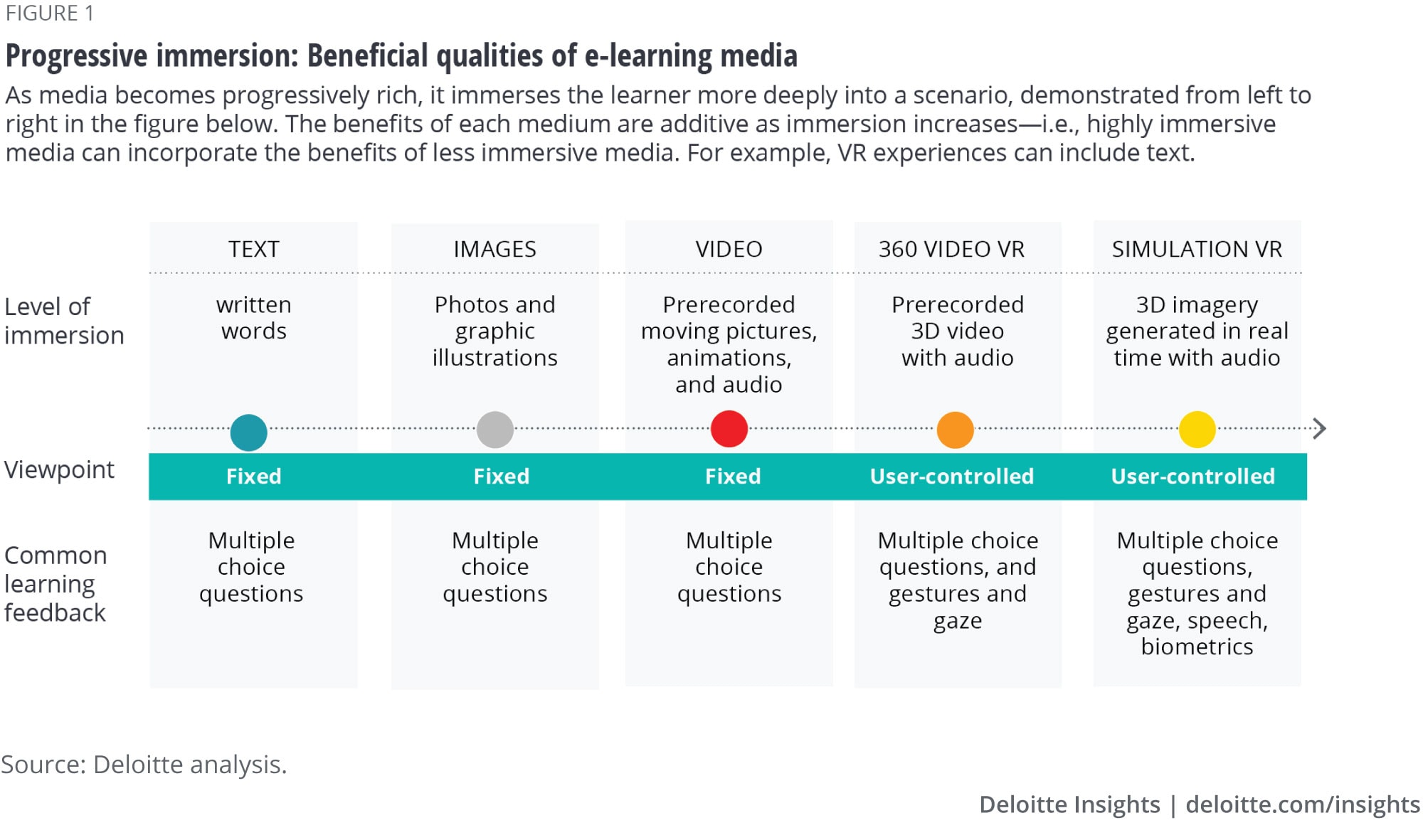
A new approach to soft skill development Immersive learning for human capabilities
14 minute read
08 May 2020
As technological advancements automate several tasks, there’s a growing opportunity for workers to look beyond technical skills and drive value creation through their human capabilities. With AR/VR and artificial intelligence, companies can offer immersive learning experiences to help employees develop their human capabilities.
Learning new skills has never been easy, and in our rapidly automating business world, workers are under increasing pressure to do so continually in order to stay relevant.1 Today, that pressure is often extending beyond just “hard” or technical skills. More and more, companies are asking their workforce to deliver value through “human capabilities”2 (see sidebar, “Rethinking the term ‘soft skills’”). Human capabilities include being able to think creatively, solve problems, build consensus, manage difficult conversations, work effectively as teams, and many other capabilities needed to deal with the human side of running a successful business. In fact, 92 percent of companies surveyed reported that human capabilities matter as much or more than hard skills in today’s business world, according to LinkedIn’s 2019 Global talent trends report.3
Learn more
Explore the digital transformation collection
Learn about Deloitte's services
Go straight to smart. Get the Deloitte Insights app
This raises big questions: How do we effectively help people cultivate their human capabilities? How do we benchmark and measure improvement of how well people perform at, well, being human? It’s a task fraught with the risk of doing more harm than good, as it asks managers and talent leaders to walk the fine line of delivering personal feedback that leads to improvement without shutting people down emotionally or discounting what makes individuals unique and valuable.
Because of human capabilities’ innate and transferrable nature, companies should think more about cultivating and honing them, as opposed to training for them. In the past, a variety of methods have been used—some more scalable, such as standardized online modules, and others that are more personalized and time-intensive, such as coaching and mentoring. More personal approaches have typically been used for leadership and management skills; however, the expense associated with more effective methods has historically caused these investments to be reserved for top talent and developing leaders.4
As demands increase for the entire workforce to demonstrate higher proficiency in these areas, companies are looking for effective learning solutions that can be delivered cost-effectively and flexibly to more workers. Here, immersive learning opportunities could offer a promising opportunity. By leveraging augmented and virtual reality (AR/VR), 360 video, and, more recently, avatars driven by artificial intelligence (AI), companies may finally be able to deliver more personalized development opportunities for human capabilities at scale.
Rethinking the term “soft skills”
“The concept of ‘soft’ is losing its foothold in the workplace today … More and more, in the workplace I'm living in, I see worlds of gray. I don't see just soft and hard. I see everyone needing the ability to act like humans and engage with people to get their jobs done.”—Summer Salomonsen, head of Cornerstone Studios.5
As new workforce trends take hold, many organizations are scrambling to fill vacancies and anticipate workforce gaps. Skills are becoming the main currency. Much like dollars and cents, however, the currency of skills is often broken down into two units of measure—hard skills, relating to technical expertise, and soft skills for more interpersonal or “human” skills. This line of thinking could guide some organizations down a path of placing too much value on hard skills over soft skills, simply by merit of connotation. “Soft” in this context may infer something less than or unimportant, whereas “hard” might appear more tangible and, thus, more valuable. This potential conclusion could lead to diminished results for businesses.
Readers should consider shifting away from language such as “soft skills” to avoid diminishing the value of what makes us truly human. The term “enduring human capabilities” is intended to be a more meaningful phrase to describe observable human attributes6—the very abilities needed to adapt our technical skills across multiple contexts.
The case for using immersive technologies to build human capabilities
Immersive learning technology has shown significant benefit in helping people gain skills and learn to react in physically dangerous scenarios7—from helping workers land a fighter jet on an aircraft carrier to navigate an oil refinery emergency effectively.8 As a general guide, if it’s too difficult, too dangerous, or too expensive to do the training in the real world, it may make sense to do the training in a virtual world. Today, as VR is becoming known more widely as “the ultimate empathy machine,”9 many organizations have started to also acknowledge its potential to help develop human capabilities as well. Similar to physically risky scenarios, immersive learning for human capabilities can help workers to practice difficult interpersonal situations without risking the potential emotional fallout that can be detrimental to both customer and workplace relationships.
When Best Western identified that its front-desk staff’s ability to resolve problems was critical to improving customer relationships, it realized its workers needed help practicing customer service skills, especially when working with tired and frustrated travelers. It decided to try an avatar-based training simulation focusing on problem resolution. In the initial phase of the program, Best Western offered front-desk personnel at 380 locations the opportunity to participate in two live-virtual simulations. In the sessions, staff could interact with characters that present challenges similar to those encountered in real life. Afterward, they discussed scenarios with managers to improve decision-making in the future. The average cost was less than US$165 per hotel.10
The results reported were promising; participating locations showed measurable gains in guest satisfaction compared to nonparticipating locations. Vice president of operations, Bruce Wienberg stated, “Hotels that received the training experienced the highest short-term gains in customer satisfaction that Best Western has ever measured in such a short period of time.”11
Measurable improvements are emerging across a vast range of use cases for human capabilities, including de-escalation,12 public speaking,13 managing difficult conversations,14 improving workplace diversity and inclusion,15 interviewing,16 and sales.17 In these scenarios, learners seem to benefit from complete immersion into a virtual scene, without distraction of phones or email, where their actions and behavior affect the outcome in real time—at very low risk to real-life relationships. The individual’s sense of physical presence, having to manage their own emotional reaction to events in a dynamic environment, and the opportunity to practice, can all help learners better incorporate skills into their everyday life.18
According to Michael Casale, chief science officer at Strivr, immersive scenarios tend to provide a much better gauge on how well workers will perform in real-life situations. “What we find is that people who score really well on the multiple choice, text-based answers will often not do nearly as well when we put them in these real-life scenarios,” Casale observes.19 For emotional situations in particular, people often know how they should behave, but when a delicate situation arises, they often have difficulty overcoming their emotions and demonstrating the most effective behavior to resolve it. Immersive experiences can offer a safe place to practice without the consequences to build up this capability.
Data still isn’t conclusive for which scenarios generally benefit most from more immersive trainings (figure 1), when compared with interactive simulations on 2D screens, for example. However, learners seem to benefit from more immersion in scenarios with higher emotional intensity and environmental complexity. According to Mark Atkinson, CEO of Mursion, “If you dial up the intensity of the experience, and you believe that your skill in the conversation is important to getting the situation right, VR is so much more powerful than the 2D experience.”20

Verizon’s safety training scenario falls in into the latter category, where experiencing a robbery scenario can create a sense of danger and overwhelm. By using VR to help over 22,000 associates across 1,600 stores train for this complex scenario, the company reported that 97 percent of them say they feel prepared when put in such dangerous situations.21
Balancing cost and quality: Creating successful immersive learning at scale
More than other media perhaps, immersive learning experiences may require higher-quality design to achieve training goals, according to Vangelis Lympouridis, PhD, founder of ENOSIS VR and part-time professor at USC Viterbi School of Engineering for AR/VR and Mixed Reality. “The quality of implementation of any VR experience overpowers any other foundational construct. This is why many existing published experiments about VR are not replicable,” observes Lympouridis. “We know from the entertainment industry that bad implementations—such as in the sound, in the visuals, or in the timing of events—can throw somebody off and significantly alter outcomes. Therefore, it is necessary to understand that all desired outcomes are directly related to the quality of a highly specialized experience design and the overall production quality.”22
Since empathy is so central to human capability development, high-quality design and effective technological implementation become especially important, perhaps even more than for technical skill training. This may, in part, be a reflection of what is known as the “uncanny valley hypothesis.”23 As the appearance of a robot or avatar seems more human, many observers’ emotional responses become increasingly positive and empathetic up to a point, then drop into strong revulsion. In other words, we begin by empathizing with cartoonish figures, but as the robot or avatar becomes more realistic, but not real enough to be convincing, many become uncomfortable. However, once it crosses that “valley,” and the robot or avatar becomes less distinguishable from a human being, the emotional response becomes positive once again and approaches human-to-human empathy levels.24
Benefits of putting a digital human in the loop
A key benefit of VR training is that it can immerse the learner in interactions and provoke responses, rather than allowing merely passive observation, especially for interpersonal skills training. Speaking, or deciding what to say, when looking at a person’s face can be a far more challenging (and instructive) experience than selecting a response from a menu on a web page.
To trigger natural, conversational responses from learners, VR technology typically portrays fictitious people in the scenario. It shows how they look, emote, talk, and move. The effectiveness of the training can be significantly influenced by how believable this portrayal is. If the VR is created using 360 video, although the scenarios are often more convincing than video, the performances are still prerecorded, so the range of responses to the learners’ reactions is limited.
If the scenarios are instead simulated in real time with computer graphics, then those roles are represented by characters also known as digital humans—similar to those that appear in a computer game. These “actors” are driven by a combination of scripts performed by live humans, programmed responses, and AI. The advantage of this approach is that it is highly interactive and allows a wider range of responses from the learners.
The importance of quality design has made content creation a challenge and often expensive in the past. However, as technology has advanced, and particularly when the ability to scale across a workforce is taken into account, the costs become more favorable. The exact point a company achieves a cost benefit can be difficult to calculate because it depends on variables ranging from complexity of the training scenario, to average hourly wage of the trainee, and how much faster the material is absorbed by the learner compared to other methods.
Calculating the precise return on investment will likely remain challenging for human capability development, due to the difficulty of measuring human capabilities themselves, and defining just how they interact with technical proficiency to achieve successful outcomes. However, Kyle Jackson, CEO and co-founder of Talespin, an immersive training startup, says, “From deployments across all of our clients, we have seen that VR is consistently more cost effective than other modalities when it’s used for about 1,500 employees. Factors that contribute to this cost benefit include reduced time to proficiency and reduced time to train because learners are taking in so much and true retention happens much faster. VR allows you to spend less of each employee’s time and get increased results in multiple dimensions. In our rollouts, we have seen substantial gains in retention, confidence, learner satisfaction, and decision-making accuracy, among other metrics.”25
Meanwhile, technological advances continue to improve immersive learning experiences, making them easier and more affordable for enterprise customers to implement.26 Just a few years ago, a high-quality VR system could easily cost upward of US$5,000 for the computer, hardware, and software needed to create an experience.27 Today, comparable systems, running on less hardware, are available at one-tenth of the cost, with mobile VR systems starting to come in around US$500.28 Advancements have made these systems self-contained, small enough to ship to any location, and easy enough to assemble in just a few minutes.
These newer, more affordable systems are also often able to deliver higher-quality experiences, including wider field of views that allow for an increased sense of realism. Additionally, new forms of hand tracking and haptics, which involve the sense of touch, are taking immersion to the next level. All of these advancements can help improve the user experience; they also provide more data to measure effectiveness and support the development of new learning experiences.
Newer hardware is also starting to integrate biometric sensors—such as eye tracking, tone of voice measurement, heart rate, and respiration rate. “Over this last year, we have started to see really high-quality eye tracking come into the market,” notes Tony Bevilacqua, CEO of Cognitive3D, a company focused on AR/VR measurement. “I think that’s one of the big shifts that we’ve been seeing recently, as commercial devices enter the market with proper biometric sensors, we are able to leverage that for enterprise use.”29 As this data becomes available, companies are also advancing their ability to integrate immersive learning into their learning management systems. This should allow them to better track completion and results of training, which over time can contribute to clearer demonstration of ROI and immersive training efficacy.30
Considerations for measurement and feedback
Developing human capabilities can place workers in very emotionally vulnerable experiences. As realism increases and our ability to track biometric responses improves, evaluations are likely to become deeply personal, making it important that employers and managers take into account some ethical and emotional considerations. More than ever, it should push trainers and managers to ask themselves: Am I demonstrating empathy and inclusivity in the way results are interpreted and feedback is delivered?
People come from a variety of backgrounds, and our interpersonal skills are often influenced by cultural, neurological, and gender norms—for example, some cultures may value eye-contact and directness, while others may find them threatening or rude.31 So, particularly for human capability development, it can be important not to simply measure to a standard rubric of behavior with a pass or fail attitude. A curiosity and understanding about why a person may have behavioral habits can be important if organizations intend to create inclusive workplaces and improve their workforce’s human capabilities.
There may be some desire—both on the part of managers and workers—to receive a simple score, like a report card. However, a more interpersonal approach may be more effective in helping workers to develop flexible and broadly applicable human capabilities. For instance, “tracking” is one way therapists often help children with neurological or learning disabilities relate better with others. It seeks to measure how well two people are reading and adapting to the other’s emotional response by asking each individual when they felt most connected in a situation. If the two follow each other and report strong connection at the same time, the tracking level is high. The goal of this method is not to check boxes on certain behaviors, such as whether or not eye contact was sustained or “active listening” responses were delivered. Instead, it seeks to evaluate whether a person can connect and adapt to the needs of another. With this method, the outcome becomes most important and the behaviors tracked are treated like clues as to what can be adjusted to improve future outcomes. This method can also help to mitigate issues around privacy and usage of employee data, especially as biometric data becomes more prevalent.
Regardless of the approach to feedback, the more personal nature of data relating to human capabilities makes ethical and transparent use particularly important. Clearly disclosing what type of data is being reported, how long it’s going to be retained, and ultimately what it can be used for is the most basic step. It should be part of ongoing discussions for talent leaders. This is a complex and important issue that cannot be covered fully here, but should not be underestimated or overlooked. For more recommendations on the ethical use of data and technology, please read Building digital trust and Ethical tech.
To invest in human skills is to invest in adaptability
Today, human capabilities are increasingly becoming foundational to a business’ ability to compete. Immersive learning can offer a scalable opportunity for companies to provide quality development opportunities for enduring capabilities such as communication, management, customer service, and beyond. Talespin’s Kyle Jackson points to the enduring value of these capabilities: “To me, soft skills training is about teaching people to adapt when you get dealt something you didn’t expect. It’s about having to think on your feet and respond in a way that's going to get the best possible outcome. The real gold is how, as individuals, we can all get comfortable with the fact that we are living in a constant rate of change.”32
As more companies explore immersive technology to develop its workforce’s human capabilities, it’s important to keep some considerations in mind:
- Quality of the content can be critical in immersive human skills training. Investing in realistic and dynamic immersive trainings tend to be the most effective.
- Measurement and communication of feedback should be human. The personal nature of most trainings requires empathy and an inclusive mindset when delivering feedback. Adding biometric information into the feedback can help deliver more personalized and actionable improvement areas.
- Technology is developing quickly and costs are dropping. Though the rate of change may be quick, learning to design, manage devices, and navigate the unique needs of a virtual training program are expected to be necessary well into the future.
- Data privacy is becoming more crucial. Be sure to make your workers aware of what is being tracked and recorded to ensure a trustworthy and ethical environment for learning.
As the pace of change continues to accelerate and automation bites more and more into analytic, administrative, and repetitive tasks, enduring human capabilities will likely only gain in their importance. Immersive technology is one way to extend important development opportunities to increase your workforce’s human capabilities and adaptability. Ultimately, democratizing the cultivation of human capabilities across your workforce could be the best way to protect your company’s access to competitive, adaptable talent for the future.
Learn more about the Future of Work
-
Future of work Collection
-
Talent and workforce effects in the age of AI Article4 years ago
-
Looping in your new sidekick Article4 years ago
-
Redefining work for new value Article4 years ago
-
Expected skills needs for the future of work Article4 years ago
-
Automation with intelligence Article5 years ago

















